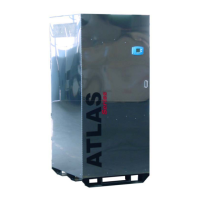18
Rev 2.1
Note: Your Atlas Series Condensing Boiler requires Category IV venting. (See NFGC, NFPA 54, Section 7 “Venting
Equipment” for more detailed information).
The Atlas is designed to operate with a chamber pressure of 0 to +0.5" w.c. The Atlas Condensing boiler is capable of
100 feet of vertical equivalent exhaust when equipped with the standard exhaust vent. When more than 100 feet of
exhaust venting is used, the chamber pressure could increase beyond the maximum designed +0.5”w.c. An optional
enlarged vent maybe be used to increase vent runs in case more than the 100ft maximum is needed, however venting
must be designed by a professional to ensure the boiler chamber pressure stays within the designed range. Boiler vents
must be constructed of AL29-4C or similar suitable material acceptable for use with exposure to condensate.
Atlas combustion air intake can be taken using the boiler room air or may be vented directly outside. When using direct
combustion air venting, the Atlas is capable of up to 30ft of equivalent venting. If more than 30ft of equivalent venting
must be used, an enlarged vent diameter may be used to extend maximum vent lengths, but must be properly sized to
allow for sufficient combustion air to be supplied to the boiler. Although direct intake is possible, it is recommended to take
combustion air from a well ventilated boiler room.
Warning: Using improper venting materials can result in personal injury, death or property damage.
Support of the vent stack
The weight of the vent stack or chimney must not rest
on the boiler vent connection. Support must be provided in
compliance with applicable codes. The vent should also be installed to maintain proper clearances from combustible
materials. Use insulated vent pipe spacers where the vent passes through combustible roofs and walls.
Vent Termination Location
Note: During winter months check the vent cap and make sure no blockage occurs from buildup of snow and ice.
Condensate can freeze on the cap. Frozen condensate on the vent cap can result in a blocked flue.
1. Give special attention to the location of the vent termination to avoid possibility of property damage or personal
injury.
2. Gases may form a white vapor plume in the winter. The plume could allow hazardous flue gas in through an open
window or obstruct a window view if the termination is installed near windows.
3. Prevailing winds, in combination with below freezing temperatures, can cause freezing of condensate and
water/ice build up on building, plants or roofs.
4. The bottom of the vent terminal and air intake shall be located at least 12" above grade, including normal snow
line.
5. Un-insulated single wall Category IV metal vent pipe shall not be used outdoors in cold climates for venting gas –
fired equipment without insulation.
6. Through the wall vents for Category IV appliances shall not terminate over public walkways or over an area where
condensate or vapor could be detrimental to the operation of regulators, relief valves, or other equipment.
7. Locate and guard vent termination to prevent accidental contact by people or pets.
8. Do not terminate vent in window well, stairwell, alcove, courtyard or other recessed area.
9. Do not terminate above any door, window, or gravity air intake. Condensate can freeze, causing ice formations.
10. Locate or guard vent to prevent condensate from damaging exterior finishes. Use a rust resistant sheet metal
backing plate against brick masonry surfaces.
11. Do not extend exposed vent pipe outside of building beyond minimum distance required for vent termination.
Condensate could freeze and block vent pipe.

